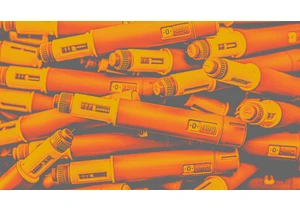Listen to the latest episode of Fast Company’s Creative Control podcast on Apple Podcasts, Spotify, RadioPublic, Google Podcasts, or Stitcher.
One would assume an inventor should make things that work. They’re supposed to identify a problem and build some innovative solution to fix it. Simone Giertz has been great about the first part but intentionally dreadful about the second.
For most of her career as an inventor and content creator, Giertz has been the self-proclaimed “Queen of Shitty Robots,” having gained a following on YouTube with inventions that were never meant to be anything more than a punch line. There was a helmet that haphazardly brushes your teeth; an alarm clock that slaps you awake with a rubber arm; and a haircutting drone with dangerous inaccuracy—each one as ridiculous as the last.
Over time, however, the joke that Giertz was hilariously bad as an inventor started to wear off for her.
“I’m a recovering self-deprecator,” Giertz says in an episode of the Fast Company podcast Creative Control. “It’s such a defense mechanism on the internet as well—like, the way you survive being an online creator is beating everyone to the joke and to the insult. I’ve been really trying to practice not talking myself down and talking down my skills.”
The catalyst for Giertz’s pivot? A brain tumor.
In 2018, Giertz was diagnosed with a noncancerous meningioma. Doctors were unable to fully remove the tumor, and what remained grew back within a year. The ordeal of surgery, radiation therapy, and simply staring down her own mortality made Giertz realize that she didn’t want to waste energy on things that didn’t work. Rather, she wanted to realize her actual dream of being a product designer.
“I had such limited energy capital, and it really put into clarity what I wanted to spend time on,” she says. “And that was building these slightly more thoughtful projects.”
Giertz created a light-up calendar to keep track of daily goals, a chair for dogs that always want to sit by you while you’re working, an adjustable table with a hidden compartment for working on jigsaw puzzles, and more. No doubt, her most ambitious “thoughtful” project to date has been converting a Tesla into a pickup truck, aka the “Truckla.”
Recently, Giertz launched her product shop, the Yetch store (“Yetch” is the phonetic spelling of her last name in English), where she’s selling functional creations that still have a touch of her humor.
In Giertz’s episode of Creative Control, she goes deeper into her pivot away from lousy robots, her modest plans to take over the product design world with the Yetch store, why she’s thinking about selling the “Truckla,” her most famous invention to date, and more.
Check out highlights below and listen to the full episode on Apple Podcasts, Spotify, RadioPublic, Google Podcasts, or Stitcher.
Being less bad
“I think if I would’ve kept on building shitty robots, I would probably have a bigger YouTube channel now. But for myself and for the longevity of my career and for my happiness and creative satisfaction, I felt like broadening it was important, and it was what I wanted to do.
“It’s important to have that very simple story in the beginning that people can latch on to. Then you can kind of expand from there. But I remember I was so scared of being pigeonholed in the beginning. It was always something that I was nervous about, because I was like, I’m gonna run out of ideas. If I don’t find ways of expanding what I’m doing, I’m gonna get stuck. I wanted to make sure that I’m the first person who gets sick of it.”
Less YouTube, More “Yetch”
“YouTube doesn’t feel like an end goal for me. I want to make products, and I want to use my YouTube channel as an R&D department. So I can make projects on YouTube. Then if there’s something there that I think has potential as a product, I can pass it over to the product team. We can manufacture it, and then I can pass it over to the YouTube channel, and I can market it to people there. It feels like it’s two businesses that can kind of seamlessly coexist and support each other, which I’m just so stoked to see how it evolves over the next 10 years.”
Finding the Yetch feel
“I want it to be relevant to people who don’t know who I am or who don’t care about who I am. But at the same time, I want people who do know who I am to be able to feel me throughout or to see that it is from me and it has a lot of that same type of humor or that same aesthetic. I wanted it to be kind of a more grown-up version of what I do.
“Sometimes it felt like an impossible brief. I wanted it to be funny but not silly. I wanted it to be expensive, kind of design-y, but not pretentious or snobby—and a little bit gritty and cool, but at the same time polished. I gave myself this impossible brief as a fledging brand developer. But I’m really happy with where it’s landed.”
Autentifică-te pentru a adăuga comentarii
Alte posturi din acest grup

If you’ve followed Apple for any length of time, you’ve no doubt come across the notion that the company doesn’t rush into adopting cutting-

Every now and then, you run into a tool that truly wows you.
It’s rare—especially nowadays, when everyone and their cousin is coming out with overhyped AI-centric codswallop tha

Tesla released its quarterly earnings report on Tuesday, its first since the company’s chief executive, Elon Musk, took up residence in the Trump White House and immediately began trying to fire f

There’s never a dull day in the world of weight-loss medication. This week brought new restrictions on compounded GLP-1 medication, the cheaper, copycat versions of brand-name drugs that tel

In December 2023, I wrote an article exploring Apple CEO Tim Cook’s most likely successors, because t

“Meta profits, kids pay the price,” was the message delivered by dozens of grieving families at the doors of Meta’s Manhattan office on Thursday.
Forty-five families traveled from

The world’s auto industry is getting a shake-up from Chinese automakers that
